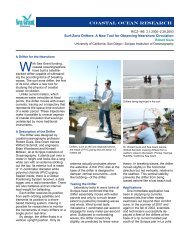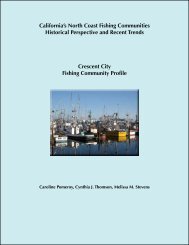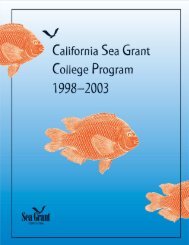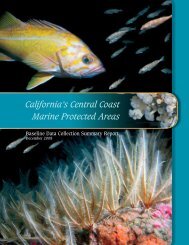2001â2002 - California Sea Grant - UC San Diego
2001â2002 - California Sea Grant - UC San Diego
2001â2002 - California Sea Grant - UC San Diego
Create successful ePaper yourself
Turn your PDF publications into a flip-book with our unique Google optimized e-Paper software.
Frontiers in Squid Reproduction: Prospecting for New Antibiotics<br />
Many bacterial diseases—tuberculosis, gonorrhea, staph<br />
and strep throat—have developed strains that can no<br />
longer be treated with standard antibiotics, leading those in<br />
the medical profession on a search for new cures.<br />
Although most antibiotics have been derived or inspired by the biochemistries<br />
of terrestrial life, it is the watery realm of the sea that may<br />
provide both the pharmaceutical industry and the public with the next<br />
generation of new treatments. Ongoing and past research by <strong>Sea</strong> <strong>Grant</strong><br />
biologist Dr. David Epel pointedly illustrates how unraveling the basic<br />
biology of marine creatures as common as the <strong>California</strong> market squid can<br />
lead to the discovery of novel biochemical pathways, the Holy Grail of<br />
drug development.<br />
For almost a decade, Epel, a biology professor at Stanford University,<br />
has been studying what he originally saw as a curiosity of squid reproduction.<br />
Female squid lay their eggs on the seafloor without burying or hiding<br />
them. For the duration of their 30-day incubation, the eggs sit on the sea<br />
bottom, totally exposed to legion microorganisms in seawater. Yet,<br />
somehow, they do not rot. They escape both bacterial and viral infection.<br />
“How is this so?” he asked.<br />
His first hypothesis was that egg sheaths must contain protective<br />
antimicrobial compounds that ward off microbial attack. In this case, he<br />
reasoned the eggs would be nearly sterile. His own experiments proved<br />
him wrong. The eggs, instead of being free of bacteria, were slathered in a<br />
bacteria-rich coating.<br />
That discovery led him to a second hypothesis: the bacteria must play a<br />
protective role in guarding against infection. Consistent with this theory,<br />
but not unto itself proof of it, Epel showed that female squid inoculate<br />
their eggs with a bacterial paste, squeezed out the accessory nidamental<br />
gland, a reproductive organ located near the egg-producing nidamental<br />
glands.<br />
In a <strong>Sea</strong> <strong>Grant</strong> project completed in 2001, he and post-doctoral researcher<br />
Dr. Todd Ciche identified 10 previously unknown species of<br />
Female squid cut open to show internal anatomy. Photo: David Epel, Stanford University<br />
bacteria on egg sheaths and in the accessory nidamental glands of market<br />
squid (Loligo opalescens). One of the new bacteria, a red carotenoidproducing<br />
alpha-proteobacteria, appears to represent a new genus. It is<br />
believed that female squid amass these bacteria from seawater.<br />
Surprisingly, however, none of these 10 bacteria alone were observed to<br />
produce antibacterial compounds. That is, when a single species of bacteria<br />
was cultured, it did not produce protective compounds. This finding<br />
prompted Epel to postulate that the group of bacteria somehow works<br />
together, perhaps communicating through chemical signals, to produce<br />
antimicrobial compounds.<br />
If this were true, other squid species could be expected to have similar<br />
assemblages of symbiotic bacteria on their egg sheaths. This is in fact what<br />
Epel observed. In an analysis of bacterial flora on three species of squid—<br />
one native to Hawaii,<br />
one native to the<br />
Mediterranean <strong>Sea</strong> and<br />
the other to the Atlantic—microbial<br />
communities<br />
on each were<br />
dominated by members<br />
“…the watery realm of the sea may<br />
provide both the pharmaceutical<br />
industry and the public with the next<br />
generation of new treatments”<br />
22











